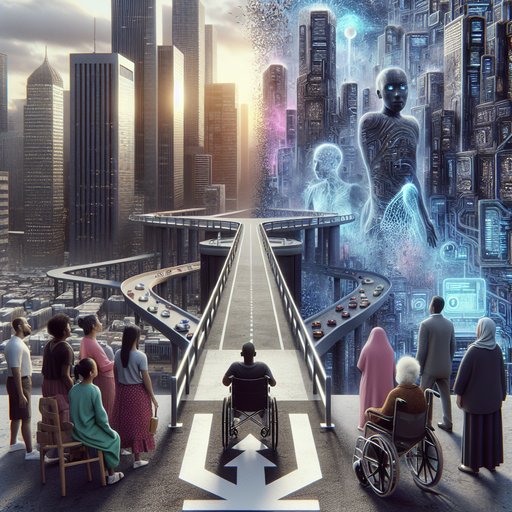
The question keeps boomeranging through boardrooms and break rooms: Will AI take your job? The query is newly sharpened by a sober headline from the computing establishment—“Will AI Take Your Job?”—which captures the cultural temperature as much as the current evidence [10]. But the more urgent version is one we too often ignore: Will AI take your job if you are disabled, chronically ill, neurodivergent, or otherwise pushed to the margins of the labor market? Whether intelligent machines become prosthetics for human capability or bulldozers of fragile opportunity depends on choices we make now—how we design, deploy, and govern tools that could either widen or bridge the access gap.
A philosophical lens clarifies what the quarterly earnings call obscures. Work is not only a paycheck; it is a scaffold for autonomy and belonging, a place where social meaning and material security meet. When technology reassigns tasks, it also redistributes dignity. The historical pattern is plain enough: innovation reliably creates and destroys—but the harms cluster where bargaining power is weakest.
If we are serious about justice, we must center those for whom the job market has always been an obstacle course. On the facts, panic and complacency both miss the mark. A Yale economist recently framed AI as a “lightning strike,” not a “house fire,” urging calm about a supposed Gen Z jobs apocalypse [1], and new data likewise suggests we are not yet living through an AI-driven collapse of employment [2]. That should steady our nerves, but lightning still kills at the margins—localized, intense, and unforgiving.
For disabled workers who are often first to be screened out by brittle systems and last to be invited back when requirements tighten, small shocks can be decisive. If AI is episodic in its impact, our ethics must be continuous in its protection. The near-term drumbeat of automation is clearest in retail and logistics. Major retailers are signaling that the traditional year-end surge in hiring may not come, dampening seasonal opportunities that once offered a foothold to many seeking flexible hours or a second chance [3].
At the same time, Walmart has taken a major step to automate grocery tracking, an emblem of how inventory work is migrating from human clipboards to sensor-rich systems [4]. These shifts do not automatically spell doom, but they do raise a design question: when discrete tasks are absorbed by machines, will the remaining roles be reimagined with accessibility at their core, or will they calcify around new barriers—unpredictable interfaces, unforgiving pace, inaccessible monitoring? iRobot’s founder cautions us not to believe the AI-and-robotics hype, a timely reminder that storytelling outruns engineering more often than not [5]. The danger is not only technological disappointment but policy distortion: hype cycles tug budgets toward shiny pilots while mundane accommodations languish.
Disabled employees do not need breathless demos; they need durable tools, clear documentation, and interfaces that respect different ways of sensing and moving through the world. Skepticism, properly applied, becomes an ally of inclusion—channeling investment from spectacle toward standards that work on an ordinary Tuesday. But even tempered expectations cannot ignore the human costs when automation fails the people around it. A $51 million lawsuit against Tesla has thrown a spotlight on the human toll in the automation revolution, reminding us that the friction between machines and bodies is not abstract [6].
Whether the harm is physical injury, deskilling, or economic displacement, the lesson is consistent: safety, redress, and worker voice must be built into deployments, not bolted on afterward. For disabled communities, the stakes are compounded; a workplace that treats harm as collateral damage is one that treats access as optional. Demography adds a complication—and an opportunity. Arguments for the social benefits of gradual population decline suggest that smaller workforces can be compatible with flourishing if we adapt institutions intelligently [7].
In that light, AI and automation can be framed not as job thieves but as force multipliers that keep essential services humming with fewer hands. The litmus test is whether these systems expand participation or narrow it. If shrinking headcounts become a rationale to ignore accessibility, we will entrench exclusion; if they become a prompt to redesign roles so that more people can contribute—including those historically sidelined—we will convert demographic headwinds into moral progress. Generational narratives, too, need recalibration.
The “Gen Z hiring nightmare” makes headlines for good reason, yet the same sources pleading for calm also suggest we are not staring at an economy on fire [1][2]. That creates space to do the slow work of inclusion: apprenticeships that teach not only AI literacy but also assistive tech mastery, mentoring that pairs digital natives with older workers whose tacit knowledge is invaluable, and cross-generational norms that destigmatize disclosure and accommodation. Accessibility is not charity; it is a productivity strategy that treats variation as a feature of the workforce, not a bug to filter out. We can glimpse constructive models in collaborative ecosystems that braid logistics, reuse, and community benefit.
Consider how partnerships in France—like the extension of cooperation between Log’ins and Recyclivre—signal the staying power of mission-aligned operations when values are explicit [8]. While such announcements are not blueprints for inclusion by themselves, they are reminders that supply chains are designed artifacts, not acts of nature. With intention, the same data flows that optimize routes and inventories can also optimize for human flourishing—training time, flexible scheduling, and interfaces that don’t punish atypical bodies or minds. The ethical dilemmas are concrete.
Algorithms that assign shifts, track keystrokes, or flag “low performers” can easily encode ableism if they equate variability with failure. Retailers declining to staff up for the holidays may lean harder on surveillance tech to squeeze throughput from fewer workers, a pattern that can be especially punishing for those who need rest breaks or assistive devices [3]. In distribution centers that layer sensors atop sensors, accessibility must include privacy and dignity: a right to explain, to appeal, and to be measured by outcomes that matter rather than proxies that discriminate. If AI is to be our co-worker, it must also be our citizen—subject to rules, responsibilities, and respect.
So, will AI take your job? If you are disabled, the honest answer is that it could take it—or make it—depending on whether we build with you, not merely for you. The path forward begins with disability-led co-design that compensates lived expertise, because nothing about us without us is more than a slogan; it is a development methodology. It continues with multimodal interactions by default—text, speech, haptics, and visual cues in parallel—so no single sense becomes a single point of failure.
It requires graceful degradation and human fallback in every workflow, since accessibility is measured by the worst day, not the best demo. And it demands procurement rules that treat accessibility as a gate, not a garnish, aligning incentives so vendors ship inclusivity on day one. If we adopt those principles, the headline softens into a better question: Will AI take the parts of your job that block your potential, and return to you the parts that express it? With sober attention to evidence, a refusal to be mesmerized by hype, and a commitment to universal design, we can ensure the answer is yes for every age and ability—machines shouldered into the background, people moved to the front [5][4][1][2][9].
That is not utopia; it is a work plan. And on a planet that must learn to do more with less, dignifying the widest possible circle of contributors is how we keep the lights on—ethically, sustainably, together [7][8].
Sources
- The Gen Z hiring nightmare is real, but AI is a ‘lightning strike’ not a ‘house fire,’ Yale economist says (Fortune, 2025-10-02T17:20:03Z)
- The AI jobs apocalypse is not yet upon us, according to new data (Fortune, 2025-10-02T17:53:09Z)
- Retailers Say No, No, No To Holiday Season Hires For Christmas Rush (Forbes, 2025-09-29T16:18:19Z)
- Sensory Upload: Walmart Expands Automation of Grocery Tracking (Thedailyupside.com, 2025-10-03T09:30:00Z)
- iRobot Founder: Don't Believe the (AI and Robotics) Hype (Crazystupidtech.com, 2025-09-29T20:19:08Z)
- A $51 million lawsuit against Tesla spotlights the human cost of the automation revolution (Naturalnews.com, 2025-09-30T06:00:00Z)
- The Case for Gradual Population Decline (Project Syndicate, 2025-10-03T09:38:23Z)
- Log’ins Extends Longstanding Partnership with Recyclivre in France (GlobeNewswire, 2025-10-02T11:00:00Z)
- Will AI Take Your Job? (Acm.org, 2025-10-02T15:41:10Z)












































